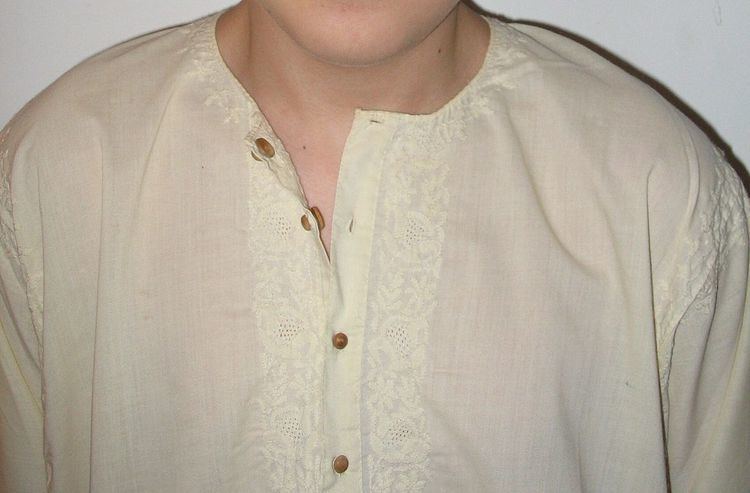 | ||
Chikan (Hindi: चिकन, Urdu: چکن) is a traditional embroidery style from Lucknow, India. Literally translated, the word means embroidery. Believed to have been introduced by Nur Jehan, the wife of Mughal emperor Jahangir, it is one of Lucknow's best known textile decoration styles. The market for local chikan is mainly in Chowk, Lucknow.
Contents
Origin
There are references to Indian chikan work as early as 3rd century BC by Megasthenes, who mentioned the use of flowered muslins by Indians. There is also a tale that mentions how a traveler taught chikan to a peasant in return of water to drink. However, the Noor Jahan story is the most popular of the lot.
Chikan began as a type of white-on-white (or whitework) embroidery.
Technique
The technique of creation of a chikan work is known as chikankari (चिकनकारी چکن کاری). Chikan is a delicate and artfully done hand embroidery on a variety of textile fabric like muslin, silk, chiffon, organza, net, etc. White thread is embroidered on cool, pastel shades of light muslin and cotton garments. Nowadays chikan embroidery is also done with coloured and silk threads in colours to meet the fashion trends and keep chikankari up-to-date. Lucknow is the heart of the chikankari industry today and the variety is known as Lucknawi chikan.
Chikan work in the recent times has adapted additional embellishments like Mukaish, Kamdani, Badla, Kamdani, sequin, bead and mirror work, which gives it a rich look. Chikan embroidery is mostly done on fabrics like cotton, semi-Georgette, pure Georgette, crepe, chiffon, silk and any other fabric which is light and which highlights the embroidery. The fabric cannot be too thick or hard, else the embroidery needle won't pierce it.
The piece begins with one or more pattern blocks that are used to block-print a pattern on the ground fabric. The embroiderer stitches the pattern, and the finished piece is carefully washed to remove all traces of the printed pattern. The process of chikankari includes following steps:
Stitches
The patterns and effects created depend on the stitches and the thicknesses of the threads used. Some of the stitches include backstitch, chain stitch and hemstitch. The result is an open work pattern, jali (lace) or shadow-work. Often the embroiderer creates mesh-like sections by using a needle to separate threads in the ground fabric, and then working around the spaces. It consists of 32 stitches:
GI status
Geographical Indication Registry (GIR) accorded Geographical Indication (GI) status for chikankari in December 2008, which recognized Lucknow as an exclusive hub of chikankari.
In popular culture
The 1986 Indian film Anjuman directed by Muzaffar Ali and starring Shabana Azmi and Farooq Shaikh is set in Lucknow and deals with issues of chikan workers.
